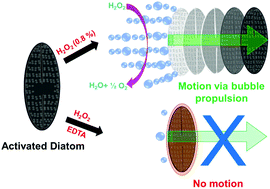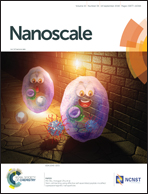Bio-inspired self-propelled diatom micromotor by catalytic decomposition of H2O2 under low fuel concentration†
Abstract
Recently, active bubble-propelled micromotors have attracted great attention for fuel applications. However, for generating bubble-propelled micromotors, additional catalysts, such as Pt, Ag, and Ru, are required. These catalysts are expensive, toxic, and highly unstable for broad applications. To overcome these issues, in this study, we present an innovative methodology for the preparation of self-propelled motor machines using naturally occurring diatom frustules. This natural diatom motor shows effective motion in the presence of a very low concentration (0.8%) of H2O2 as a fuel at pH 7. Due to the unique 3D anisotropic shape of the diatom, the self-propelled motor exhibited unidirectional motion with a speed of 50 μm s−1 and followed pseudo first-order kinetics. It was found that a trace amount of iron oxide (Fe2O3) in the diatom was converted into Fe3O4, which can act as a catalyst to achieve the facile decomposition of H2O2. Interestingly, “braking” of the unidirectional motion was observed upon treatment with EDTA, which blocked the catalytically active site. These results illustrate that diatom catalytic micromotors have opened a new era in the field of catalysis and bioengineering applications.



 Please wait while we load your content...
Please wait while we load your content...